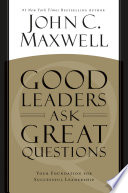

At the heart of effective leadership lies the ability to ask the right questions. Questions are not merely tools for gathering information; they are instruments for fostering deeper conversations, encouraging reflection, and driving engagement within teams. Leaders who master the art of questioning can unlock the potential of their team members by prompting them to think critically and creatively. This approach not only enhances decision-making but also builds a culture of collaboration and trust. The book emphasizes that the quality of questions often determines the quality of answers, and thus, leaders must be intentional about the questions they pose.
Continue readingEffective leadership is as much about listening as it is about asking questions. The book highlights that leaders who actively listen create an environment where team members feel valued and understood. Listening goes beyond hearing words; it involves paying attention to non-verbal cues and understanding the emotions behind the message. By fostering a culture of open dialogue, leaders can cultivate trust and loyalty among their teams. This idea underscores the importance of empathy in leadership, as it allows leaders to connect with their team members on a deeper level, enhancing overall team dynamics.
Continue readingA curious organization is one that thrives on innovation and adaptability. The book discusses how leaders can instill a culture of curiosity by encouraging team members to ask questions and explore new ideas. This culture not only drives creativity but also helps organizations stay ahead in a rapidly changing business landscape. Leaders can model curiosity by being open to feedback and willing to explore diverse perspectives. By promoting an environment where questioning is welcomed, leaders can empower their teams to take initiative and contribute to continuous improvement.
Continue readingThe book posits that questions can serve as powerful catalysts for personal and professional growth. Leaders can use questions to guide their teams through challenges, encouraging them to reflect on their experiences and learn from them. This approach fosters a growth mindset, where failures are seen as opportunities for learning rather than setbacks. By framing challenges as questions, leaders can help their teams navigate obstacles with resilience and creativity. This idea reinforces the notion that growth is a continuous journey, and asking the right questions is a key part of that process.
Continue readingOne of the most impactful roles of a leader is to empower others. The book emphasizes that asking empowering questions can help team members take ownership of their work and develop their problem-solving skills. By shifting the focus from providing answers to facilitating discussions, leaders can encourage autonomy and accountability within their teams. This empowerment not only boosts morale but also enhances productivity, as team members feel more invested in their roles. The idea is that when leaders ask the right questions, they enable their teams to discover solutions and drive results.
Continue readingDecision-making is a critical aspect of leadership, and the book highlights how questions can play a pivotal role in this process. Leaders are encouraged to ask questions that challenge assumptions and explore different viewpoints. This approach leads to more informed and balanced decisions, as it encourages thorough analysis and consideration of potential outcomes. By fostering an environment where questioning is part of the decision-making process, leaders can mitigate risks and enhance the quality of their choices. This idea reinforces the importance of critical thinking in leadership.
Continue readingEngagement is essential for team performance, and the book discusses how leaders can sustain engagement through inquiry. By regularly asking questions that invite participation and input, leaders can keep their teams motivated and involved in the decision-making process. This ongoing dialogue fosters a sense of belonging and commitment among team members, which is crucial for maintaining high levels of engagement. The idea is that when team members feel their voices are heard and valued, they are more likely to contribute actively and passionately to the organization's goals.
Continue reading